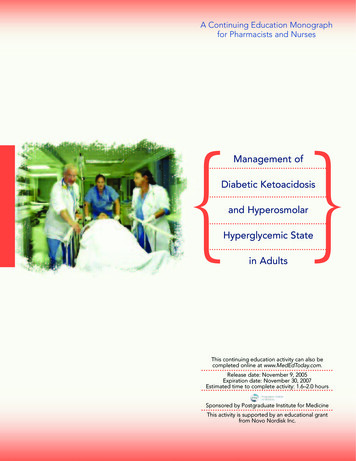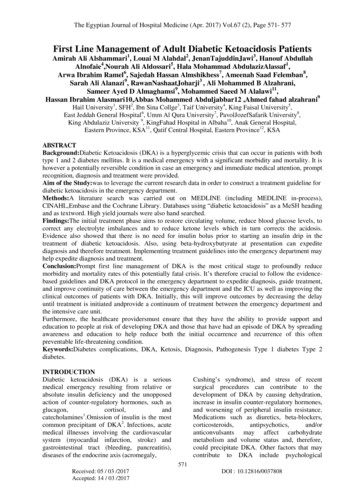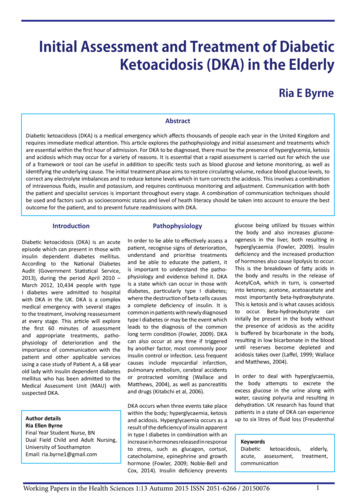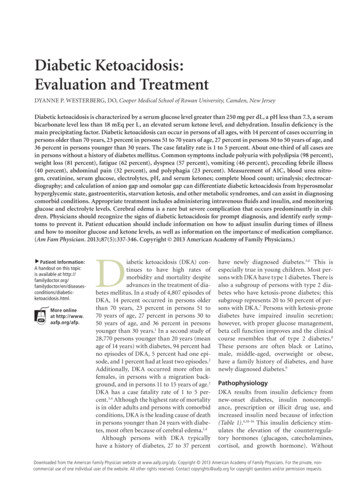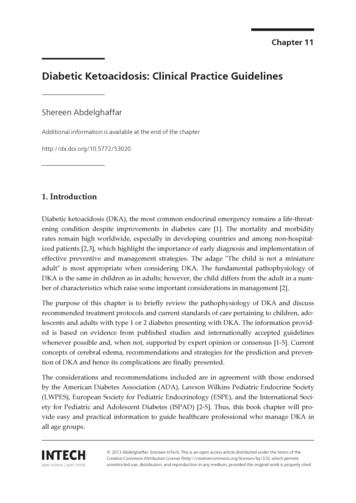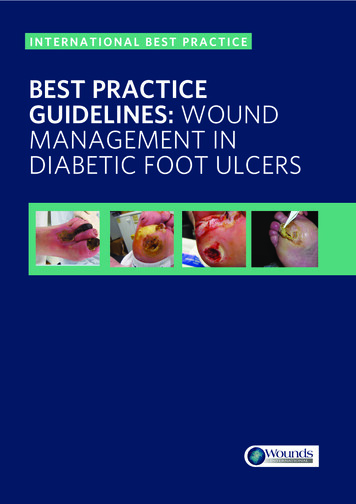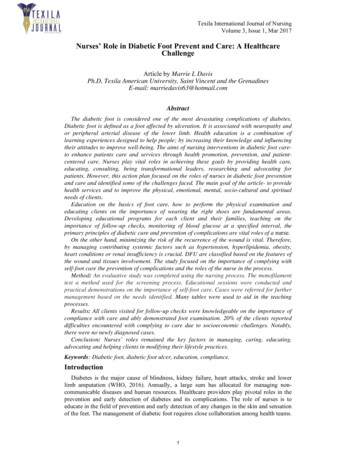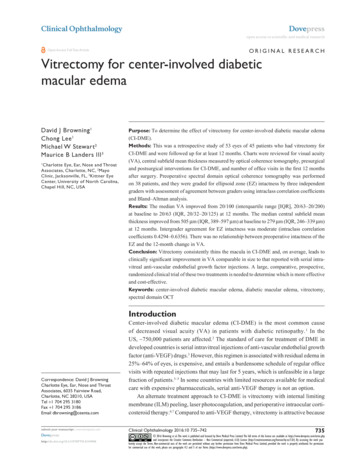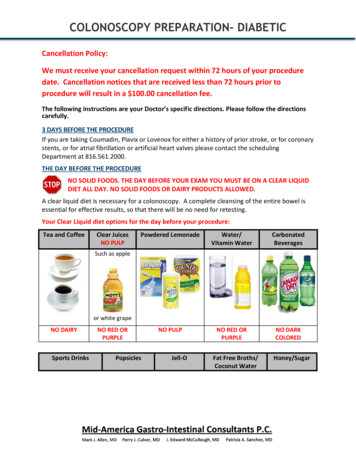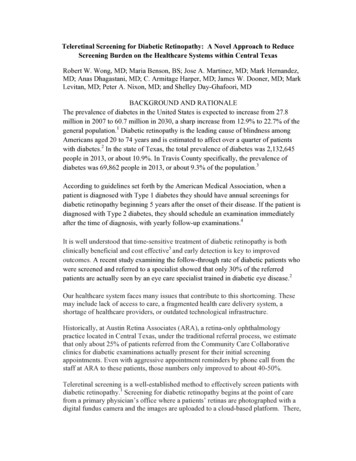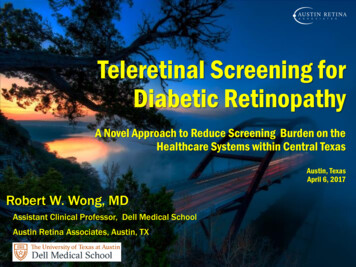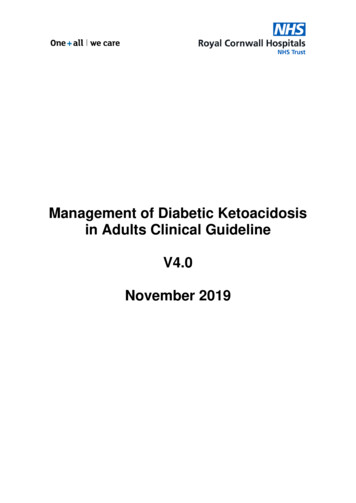
Transcription
Management of Diabetic Ketoacidosisin Adults Clinical GuidelineV4.0November 2019
SummaryDiabetic ketoacidosis (DKA) is a complex disordered metabolic state characterised byhyperglycaemia, acidosis, and ketonaemia. DKA usually occurs as a consequence ofabsolute or relative insulin deficiency that is accompanied by an increase in counterregulatory hormones. Mortality rates have fallen significantly in the last 20 years from7.96% to 0.67% due improved understanding and appropriate management.The main causes of mortality in the adult population include severe hypokalaemia,adult respiratory distress syndrome, and co-morbid states such as pneumonia, acutemyocardial infarction and sepsis.Cerebral oedema remains the most common cause of mortality, particularly in youngchildren and adolescents, therefore intravenous fluids must be given cautiouslydepending on clinical observations.Management of Diabetic Ketoacidosis in Adults Clinical Guideline V4.0Page 2 of 11
1. Aim/Purpose of this Guideline1.1. This guideline is for the management Diabetic Ketoacidosis (DKA) in adultsand adolescents admitted under adult medical care only. It has beenbenchmarked against Joint British Diabetes Societies (JBDS) guidance, toprovide guidance on the clinical management of DKA in line with best practiceguidelines. However it remains the clinician’s responsibility to use clinicaljudgment and application of the guidance depending on individual circumstances.1.2. This version supersedes any previous versions of this document.1.3. Data Protection Act 2018 (General Data Protection Regulation – GDPR)LegislationThe Trust has a duty under the DPA18 to ensure that there is a valid legal basisto process personal and sensitive data. The legal basis for processing must beidentified and documented before the processing begins. In many cases we mayneed consent; this must be explicit, informed and documented. We can’t rely onOpt out, it must be Opt in.DPA18 is applicable to all staff; this includes those working as contractors andproviders of services.For more information about your obligations under the DPA18 please see the‘information use framework policy’, or contact the Information Governance Teamrch-tr.infogov@nhs.net2. The Guidance2.1. Principles of DKA Treatment2.1.1. Insulin is given intravenously at a Fixed Rate Intravenous InsulinInfusion(FRIII) which is based on weight (0.1units/kg/hour).2.1.2. 0.9% Sodium chloride(0.9%NaCl) should be given for all fluidresuscitation.2.1.3. Potassium should be replaced and closely monitored.2.1.4. Continue Long acting insulin at pre-admission dose along with IVinsulin.2.1.5. Response of treatment should be assessed by hourly bed sidecapillary ketones and glucose and 2 hourly PH.2.1.6. All patients should be reviewed by diabetes team prior to discharge.2.2. Recommended Targets2.2.1. Reduction of the blood ketone concentration by 0.5mmol/L/hour.2.2.2. Increase the venous bicarbonate by 3.0mmol/L/hour.Management of Diabetic Ketoacidosis in Adults Clinical Guideline V4.0Page 3 of 11
2.2.3. Reduce capillary blood glucose by 3.0mmol/L/hour.2.2.4. Maintain potassium between 4.0 and 5.5mmol/L.2.3. If there is no improvement as above, then the FRIII rate should be increased (seeManagement of DKA, Appendix 4)3. Monitoring compliance and effectivenessElement to bemonitoredLeadAll of ItToolPatient Documentation using audit and review toolFrequencyAdult in-patients with diabetes who are diagnosed with DKA and whoare reviewed by the specialist diabetes teamReportingarrangementsNon-compliance will be reported to the responsible medical team,ward /area manager.Non-compliance resulting in an adverse patientevent will be reported via DatixSpecialist Adult In-Patient Diabetes TeamActing onMedical teams / ward / area managers will undertake subsequentrecommendations recommendations and action planning for any or all deficiencies andand Lead(s)recommendations within reasonable timeframes for their areasThe Specialist Adult In-Patient Diabetes Team will undertake any trustwide recommendations and action planning for any or all deficienciesand recommendations within reasonable timeframesChange inLesson learned or changes to practice will be shared with all thepractice andrelevant stakeholderslessons to beshared4. Equality and Diversity4.1. This document complies with the Royal Cornwall Hospitals NHS Trustservice Equality and Diversity statement which can be found in the 'Equality,Inclusion & Human Rights Policy' or the Equality and Diversity website.4.2. Equality Impact AssessmentThe Initial Equality Impact Assessment Screening Form is at Appendix 2.Management of Diabetic Ketoacidosis in Adults Clinical Guideline V4.0Page 4 of 11
Appendix 1. Governance InformationDocument TitleManagement of Diabetic Ketoacidosis inAdults Clinical Guideline V4.0Date Issued/Approved:15 November 2019Date Valid From:November 2019Date Valid To:November 2022Directorate / Department responsible(author/owner):Amanda Veall, Lead Clinical NurseSpecialist DiabetesContact details:01872 253014Brief summary of contentsTo provide guidance on the management ofdiabetic ketoacidosis in adultsSuggested Keywords:Target AudienceDiseases, Endocrine diseases, Diabetes,Measurement, Clinical measurement,Diagnosis, Care, Health care, Medicalcare, Medical treatment, Diabetic care,Tests, Diagnostic testsRCHT CFTKCCGExecutive Director responsible forPolicy:Medical DirectorDate revised:15 November 2019This document replaces (exact title ofprevious version):Clinical Guideline for the Management ofDiabetic Ketoacidosis (Dka) in Adults V3.0Consultant Endocrinologists, Diabetes InPatient Specialist Nurses, ConsultantBiochemistApproval route (names ofcommittees)/consultation:Care Group General Managerconfirming approval processesSidwell LawlerName and Post Title of additionalsignatoriesNot RequiredName and Signature of CareGroup/Directorate Governance Leadconfirming approval by specialty andcare group management meetingsSignature of Executive Director givingapproval{Original Copy Signed}Name: Becky Osborne{Original Copy Signed}Management of Diabetic Ketoacidosis in Adults Clinical Guideline V4.0Page 5 of 11
Publication Location (refer to Policyon Policies – Approvals andRatification):Internet & IntranetDocument Library Folder/Sub FolderClinical / Endocrine and DiabetesLinks to key external standardsNSF for Diabetes 2001Related Documents:NHS DIABETES 2013 2eJoint British Diabetes Societies InpatientCare GroupThe Management of Diabetic Ketoacidosisin AdultsTraining Need Identified?No Intranet OnlyVersion Control TableDateVersionNoSummary of ChangesChanges Made by(Name and Job Title)Amanda VeallClinical NurseSpecialist DiabetesJan 2012V1Initial IssueJan 2013V2Updated to reflect the National Guidance,including venous PHAmanda VeallClinical NurseSpecialist DiabetesV3Review date. Guideline updated to reflect theNational Guidance including Ketones andPrescription and Monitoring ChartAmanda VeallClinical NurseSpecialist DiabetesV4.0Amanda VeallUpdated to latest Trust template and guidanceClinical Nursemoved to appendixesSpecialist DiabetesApril 2016November2019All or part of this document can be released under the Freedom of InformationAct 2000This document is to be retained for 10 years from the date of expiry.This document is only valid on the day of printingControlled DocumentThis document has been created following the Royal Cornwall Hospitals NHS TrustPolicy for the Development and Management of Knowledge, Procedural and WebDocuments (The Policy on Policies). It should not be altered in any way without theexpress permission of the author or their Line Manager.Management of Diabetic Ketoacidosis in Adults Clinical Guideline V4.0Page 6 of 11
Appendix 2. Initial Equality Impact Assessment FormName of the strategy / policy /proposal / service function to be assessedManagement of Diabetic Ketoacidosis in Adults Clinical Guideline V4.0Directorate and service area:Endocrine and DiabetesNew or existing document:ExistingName of individual completing assessment:Amanda VeallTelephone:01872 2531041. Policy Aim*Who is the strategy /policy / proposal /service function aimedat?2. Policy Objectives*3. Policy – intendedOutcomes*To provide detailed guidance on the clinical management of Adultswith Diabetes diagnosed with Diabetic Ketoacidosis To provide a consistent approach to the management ofDiabetes within RCH sites. To maintain patient safety and improve outcomes for adultpatients with diagnosed with Diabetic Ketoacidosis in RCH sites Consistent management of Diabetes at RCH sites. Prompt and safe management of Diabetic Ketoacidosis4. *How will youmeasure theoutcome?AuditDatix ReportingReview of medical / nursing documentation as required5. Who is intended tobenefit from thepolicy?All adult patients with Diabetic Ketoacidosis within all RCH sites6a Who did youconsult isationsxPlease record specific names of groupsb). Please identify thegroups who havebeen consulted aboutthis procedure.Consultant Endocrinologists, Diabetes In-Patient Specialist Nurses,Consultant Anaesthetist, Emergency Medicine Consultant, MedicalAdmission ConsultantWhat was theoutcome of theconsultation?Agreed7. The ImpactPlease complete the following table. If you are unsure/don’t know if there is a negativeimpact you need to repeat the consultation step.Management of Diabetic Ketoacidosis in Adults Clinical Guideline V4.0Page 7 of 11
Are there concerns that the policy could have differential impact on:Equality Strands:AgeYesNoUnsureRationale for Assessment / Existing EvidenceXSex (male,female, trans-gender /gender reassignment)Race / Ethniccommunities/groupsXXDisability Learning disability,physicalimpairment, sensoryimpairment, mentalhealth conditions andsome long term healthconditions.XReligion /other beliefsXMarriage andCivil partnershipXPregnancy andmaternityXSexualOrientation,Bisexual, Gay,heterosexual, LesbianXYou will need to continue to a full Equality Impact Assessment if the following havebeen highlighted: You have ticked “Yes” in any column above andNo consultation or evidence of there being consultation- this excludes any policies which havebeen identified as not requiring consultation. or Major this relates to service redesign or development8. Please indicate if a full equality analysis is recommended.YesNoX9. If you are not recommending a Full Impact assessment please explain why.Not indicatedDate of completion andsubmission15 November 2019Members approvingscreening assessmentPolicy Review Group(PRG)‘APPROVED’This EIA will not be uploaded to the Trust website without the approval of the PolicyReview Group.A summary of the results will be published on the Trust’s web site.Management of Diabetic Ketoacidosis in Adults Clinical Guideline V4.0Page 8 of 11
Appendix 3. Management of Diabetic Ketoacidosis in patientsunder adult medical careManagement of Diabetic Ketoacidosis in patients under adultmedical care (Please print and keep a copy in the medical notes)Doctor NameGrade Consultant Date & Time-------------------- -- Location ------------------DIAGNOSTIC CRITERIA: All three of the following must be presentINITIAL INVESTIGATIONS Capillary blood glucose above 11 mmol/L or known diabetes Capillary ketones above 3 mmol/L or urine ketones or more Venous pH less than 7.3 and/or bicarbonate less than 15 mmol/LSecure two large bore IV linesFBC,U&Es, LFTs, CRP,HbA1cCapillary ketonesVenous pHBlood CulturesECGChest X-RayABG if O2 saturation below94% on air Pregnancy test in women ofchildbearing age Examine Feet for diabetic footdisease and Document in notes Refer to Diabetes team viaMaxims URGENT CRITICAL CARE/HDU REVIEW if any of following present: Severe DKA by following criteria Blood ketones above 6 mmol/L Venous bicarbonate below 5 mmol/L Venous pH below 7.0 Hypokalaemia on admission (below 3.5 mmol/L) GCS less than 13 Pregnant History of CCF or CKD stage 3 or above Systolic BP below 90 mmHg Pulse over 100 or below 60 bpm Anion gap above16 [Anion Gap (Na K ) – (Cl- HCO3-)]1)(Affix label)CR no. -----------------------------Patient Name ---------------------Date of Birth ------------------------TIME 0 TO 60 MINUTES- Immediate Management: Diagnosis, Resuscitation 1-Intravenous Fluids (use large bore cannula) viainfusion pumpIf BP is 90mmHg Systolico 500ml 0.9% sodium chloride solution(0.9%NaCl) as bolus STAT and reassessIf BP is 90 mmHg Systolico 1 Litre of 0.9% NaCl over 60 minutes 2-Insulino Commence Fixed Rate Intravenous InsulinInfusion (FRIII) based on weight (0.1unit/kg/hr) Continue Long/Intermediate Acting Insulin(Abasaglar,Lantus , Levemir, Tresiba,Insulatard,Humulin I) as pre-admission dose and time.o If next planned dose is due more than 6 hours,give half of the long acting insulin as stat dose.Monitoring Observations(NEWS2)Hourly capillary blood glucoseHourly capillary ketone measurementVenous PH and potassium at 60 minutes,and 2 hourly4 hourly plasma electrolytesContinuous cardiac monitoringProphylactic LMWH if no contraindicationsFluid balance chartNB: More cautious fluid replacement in youngpeople aged 18-25 years, elderly, pregnant, heartfailure or with BMI 19 or less(Critical Care team review if there is pulmonaryoedema or low GCS)Management of Diabetic Ketoacidosis in Adults Clinical Guideline V4.0Page 9 of 11
2) 60 MINUTES to 6 HOURS Aim: Monitors response of treatmentRate of fall of ketones of at least 0.5 mmol/L/hr OR bicarbonate rise 3 mmol/L/hr and blood glucose fall 3 mmol/L/hr.Consider increasing insulin infusion rate by 1unit/hour increments if ketones not falling at this rate.Continue fluid replacement via infusion pumpas follows: (Please Tick) 0.9% NaCl 1L /- KCL over next 2 hours 0.9% NaCl 1L /- KCL over next 2 hours 0.9% NaCl 1L /- KCL over next 4 hoursBIOCHEMICAL and CLINICAL MONITORING(Please Tick)Hourly Capillary Glucose and Capillary ketones60 mins
This guideline is for the management Diabetic Ketoacidosis (DKA) in adults and adolescents admitted under adult medical care only. It has been benchmarked against Joint British Diabetes Societies (JBDS) guidance, to provide guidance on the clinical management of DKA in line with best practice guidelines. However it remains the clinician’s responsibility to use clinical judgment and .
